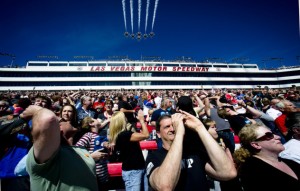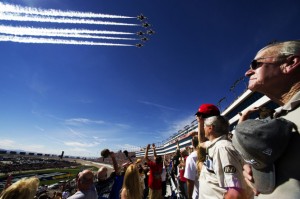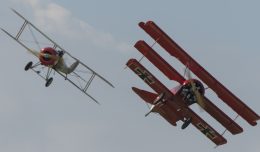 It had become a tradition, one we grew accustomed to and even expected. If you were there you couldn’t help but to look up and be moved and if viewing from television you knew what to watch for as the National Anthem came to an end, I’m talking about the flyover. Since the beginning of flight, flyovers were used to showcase and present aircraft to spectators on the ground. Whether it was a low pass over an airfield by a biplane during the 1920’s or a four-ship F-15 flyover at an NFL football game today, it served a purpose. While advertising and recruitment were paramount, it was equally effective towards those who would never join the military or own a plane. In the first few years following 9/11 it helped unite us. Years later it paid homage to the service men and woman defending our county and perhaps most important of all reminded us about what it meant to live in a free country and our new way of life as we knew it in the new millennium. And since January 2013 this tradition has come to an end until recently.
It had become a tradition, one we grew accustomed to and even expected. If you were there you couldn’t help but to look up and be moved and if viewing from television you knew what to watch for as the National Anthem came to an end, I’m talking about the flyover. Since the beginning of flight, flyovers were used to showcase and present aircraft to spectators on the ground. Whether it was a low pass over an airfield by a biplane during the 1920’s or a four-ship F-15 flyover at an NFL football game today, it served a purpose. While advertising and recruitment were paramount, it was equally effective towards those who would never join the military or own a plane. In the first few years following 9/11 it helped unite us. Years later it paid homage to the service men and woman defending our county and perhaps most important of all reminded us about what it meant to live in a free country and our new way of life as we knew it in the new millennium. And since January 2013 this tradition has come to an end until recently.
“As a result of the 2013 sequestration the directive to discontinue tactical aircraft flight demonstrations and flyovers at air shows, sporting events and other public appearances was promulgated by the Secretary of Defense,” states Mike Maus, Deputy Public Affairs Officer with the US Navy. “We, along with other military service branches are complying with that direction.”
While the grounding of all military support for flyovers afforded many civilian airshow teams and warbird owners with an opportunity to pick up the slack, it wasn’t the same. Stadium spectators didn’t fully grasp the importance of a B-25 flying over a stadium unless they had some aviation knowledge and the lack of noise made it difficult to captivate crowds and excite them in the same way a modern day fighter did.
With no military support during 2013, 2014 budgeting allowed the military to support a few select events by means of the US Navy Blue Angels and Air Force Thunderbirds. “While the Air Force is no longer supporting any flyovers for the remainder of this year, there was an exception for 2014 with a total of 4 flyovers conducted by the USAF Thunderbirds,” reports Jennifer Bentley, Chief Civic Engagement with Air Force Public Affairs, with the last of the 4 taking place after opening ceremonies Tuesday, July 15 at the 85th MLB All-Star game at Target Field in Minneapolis. While many will cheer as the six planes fly the delta formation overhead to start the game, few will do so with an understanding of what is involved in making this happen.
While the two to three-second clip broadcasted depicts six planes, there are hundreds more personnel and man hours behind the scenes that are not shown. “Once we get word that we will be supporting a flyover, we initially spend a lot of time looking at the event area via satellite imaging,” states Major Tyler Ellison, Thunderbird pilot #7 and Team Operations Officer. “We look at all factors in and around the area where the flyover is to take place with focus on location, elevation and physical obstacles such as surrounding airports, towers and buildings.” One major variable the team pays close attention to is that of other planes in the air. “With sporting events there are usually always other aircraft in and around the area,” remarks Major Ellison. “Target Field is just North of Minneapolis St-Paul International Airport so we needed to work closely with them. In addition to commercial flights, fixed wing and helicopters are also always in the vicinity at the time of a flyover to broadcast the event. As a result we work closely with ATC and the FAA in getting approval to fly lower and at faster air speeds for safety in operating our F-16’s in the area.”
 Hitting the target at the conclusion of the National Anthem
Hitting the target at the conclusion of the National Anthem
Everybody critiques it. Did the planes come over too early, on time or were they late in their flyover after the anthem had finished? “We have a refined process with respect to timing and communication since we have been doing this for so long,” states Major Ellison. “While Thunderbirds 1 through 6 are in the air flying the planes, I myself and Thunderbird #8 are actually on the playing field. I am in direct contact with the airplanes while Thunderbird #8 is in contact with the production companies. We all sit down days prior to the flyover with our team, TV production crews and anyone else involved to develop a structured script of what to expect. At this time we also sit with the person singing the anthem and have them sing it in our presence several times to help lock in timing. We work closely and focus on specifics in developing a script of what should happen second by second. Contrary to what many believe our cues for timing the flyover actually begin 4 minutes out before the actual flyby and way before the anthem begins.” At the four minute mark the six-jet team begins its turn into the event. During this four-minute flight, Major Ellison is in constant contact with Lt. Col. Greg Moseley, commander and flight lead in Thunderbird #1. “In talking with the flight lead I am getting feedback on their position and checking in with our planned script in order to assess our timing,” explains Major Ellison. “I will determine if we are on time, behind or ahead of schedule and then call out the appropriate adjustments for the team, should we need [any].”
While the team has the ability to change and adjust, the two minute and 30 second leaves minimal room for error. At two minutes and 30 seconds the team will need to decide to commit or to call the flyover off, also termed the point of commit. “At this time there is no turning around or deviating from the flight in, the planes are flying over,” states Major Ellison. “We call it the point of commit as at this stage there is no more time to allow the six-jet formation to turn around or deviate from the flight plan previously planned. Though committed, there are several things that can still be done in order to slow it down or speed things up depending on our timing. We are able to make up as much as 15 seconds in that last two minutes and 30 seconds by pushing the jets to fly at their maximum allowed speed for the event, thus allowing them to hit the target 15 seconds earlier. We are also able to slow them down to gain as much as a maximum of nine additional seconds by bringing the aircraft down to their slowest speed. We will do this if the singer goes a little long or if we are a little ahead of schedule. One of the most common things that will throw off the timing is when the crowd sees the planes. When the aircraft are seen on the Jumbotron the crowd will begin to cheer. The singer hears the cheers and will often be a little thrown off and holds the last part of the anthem until the aircraft fly over.
 While a six plane flyover will be seen on television over Target Field, it represents much more than just those six pilots. “There’s a lot of hard work that goes on behind the scenes as it’s truly a team effort involving a lot of both military and civilian personal,” remarks Major Ellison. “Our main focus and number one priority is safety. Aircraft in violation with the airspace, birds and even weather are just a few factors that can disrupt timing or cause us to call off a flyover entirely. Timing always takes a backseat to safety.”
While a six plane flyover will be seen on television over Target Field, it represents much more than just those six pilots. “There’s a lot of hard work that goes on behind the scenes as it’s truly a team effort involving a lot of both military and civilian personal,” remarks Major Ellison. “Our main focus and number one priority is safety. Aircraft in violation with the airspace, birds and even weather are just a few factors that can disrupt timing or cause us to call off a flyover entirely. Timing always takes a backseat to safety.”
Is the time and money worth it for a few seconds? Many feel it is. “In 2012 the Air Force alone flew 983 flyovers, none in 2013 and four by way of the Thunderbirds this year,” states Jennifer Bentley, Chief Civic Engagement with Air Force Public Affairs. While this number does not include flyovers supported by other service branches, the total number of flyovers averaged around 2,000 per year over the past decade. While this tradition will be helped kept alive today over Target Field, one can’t help but wonder if this change is yet another sign of things to come. While the flyover was initiated in order to unite, serve and support our military what does the absence of it mean? Either way one thing is for sure, if you think the flyover is special and have enjoyed them in the past, make sure to embrace the Thunderbirds at the All-Star game tonight as it has become even more special now.








